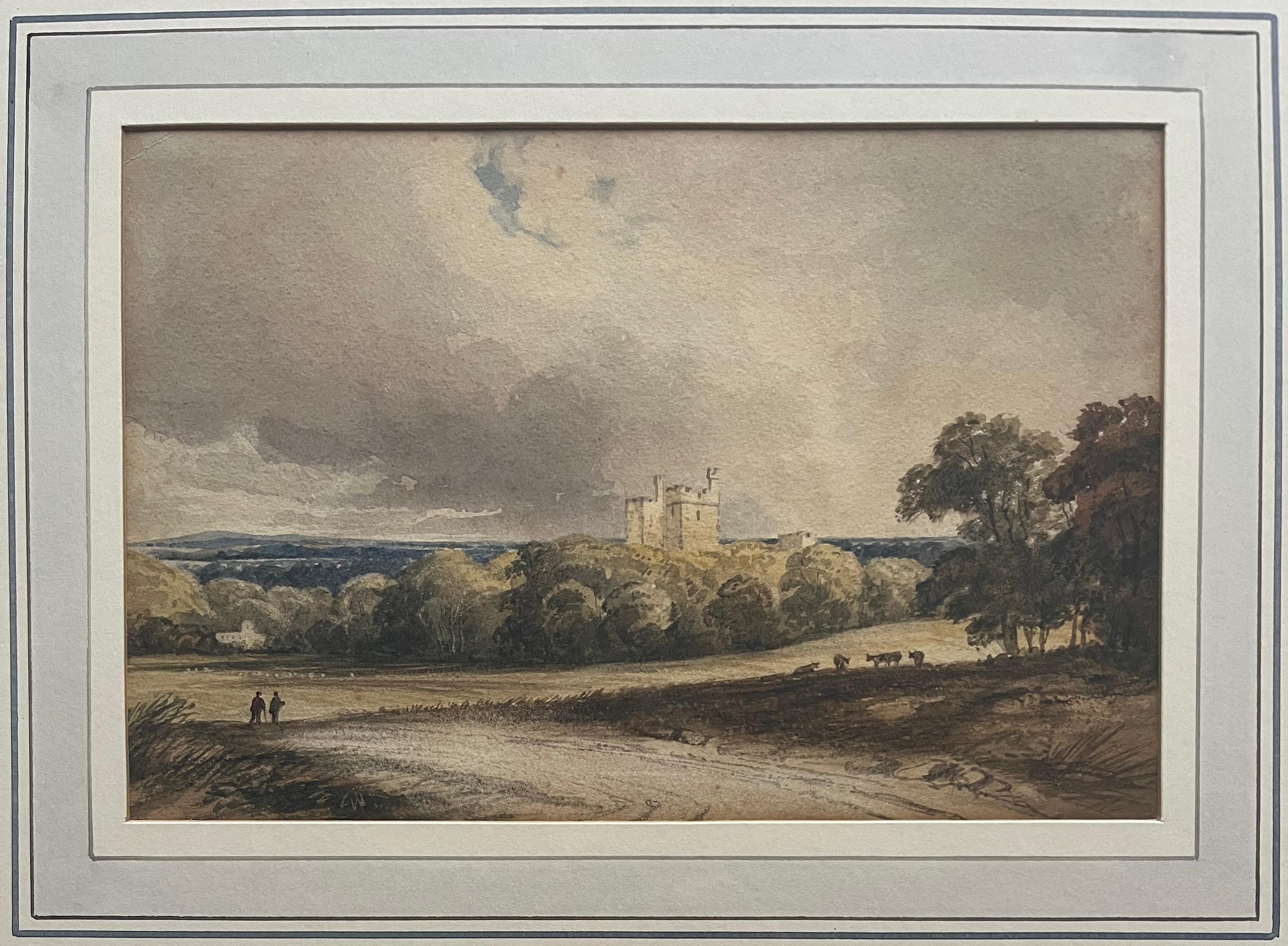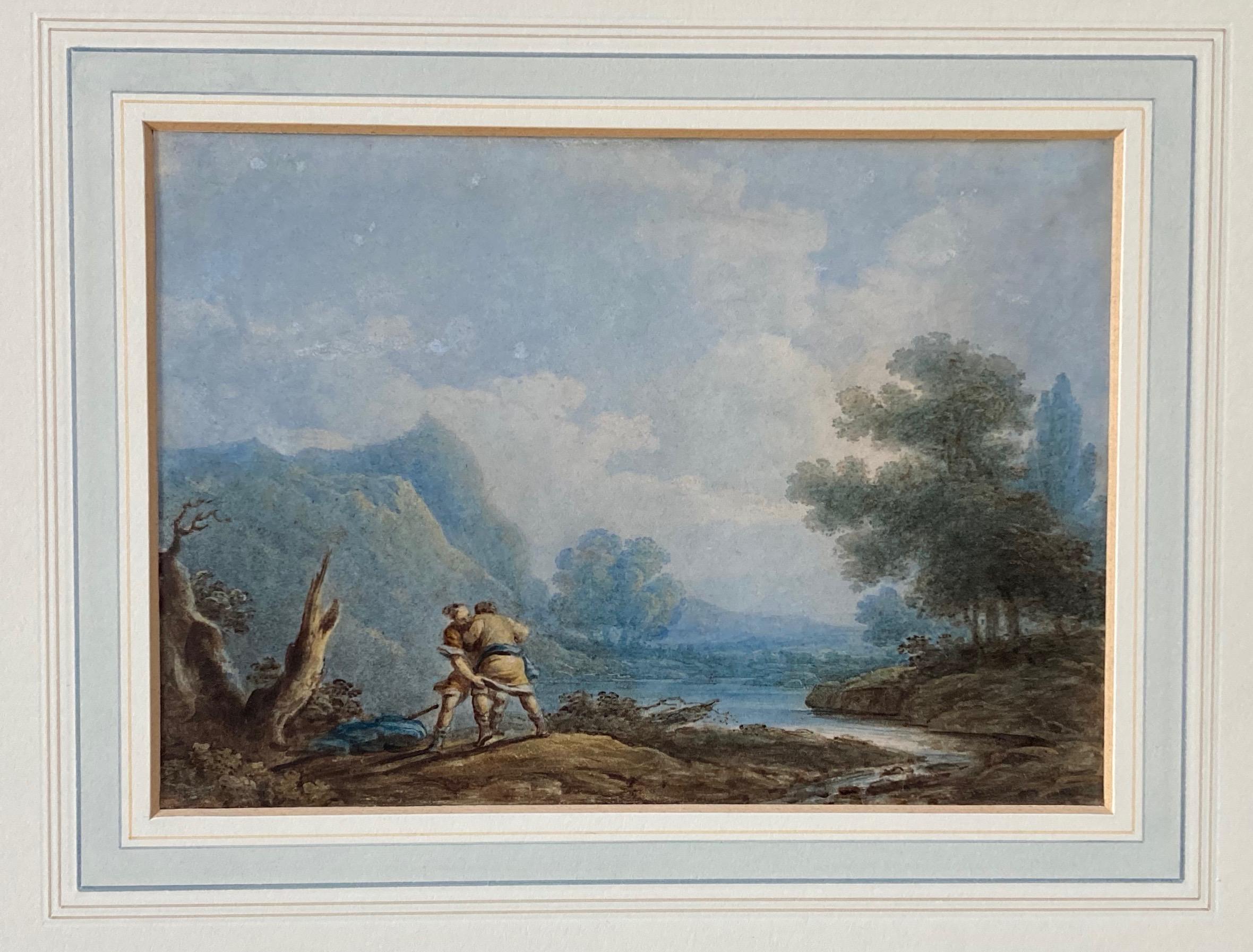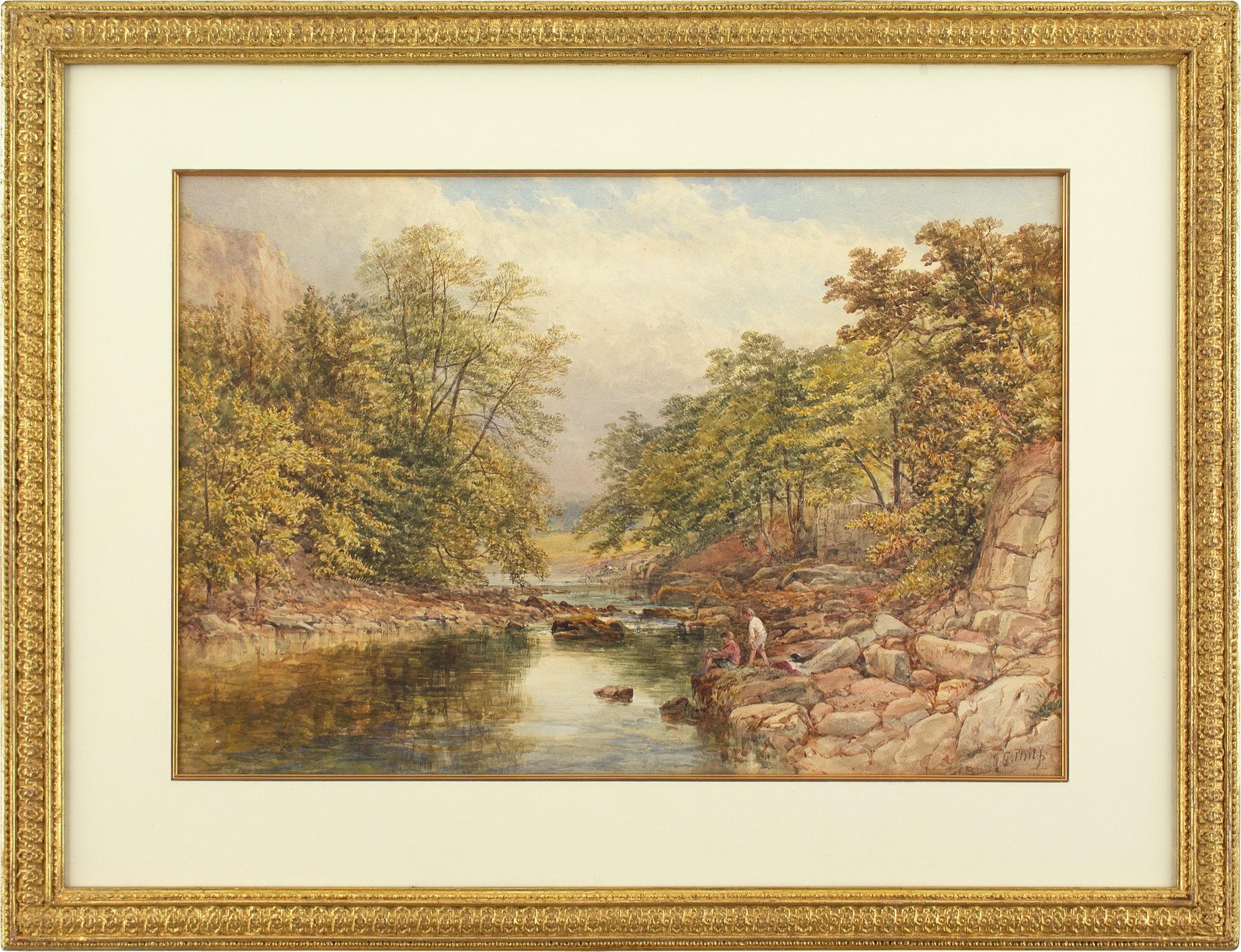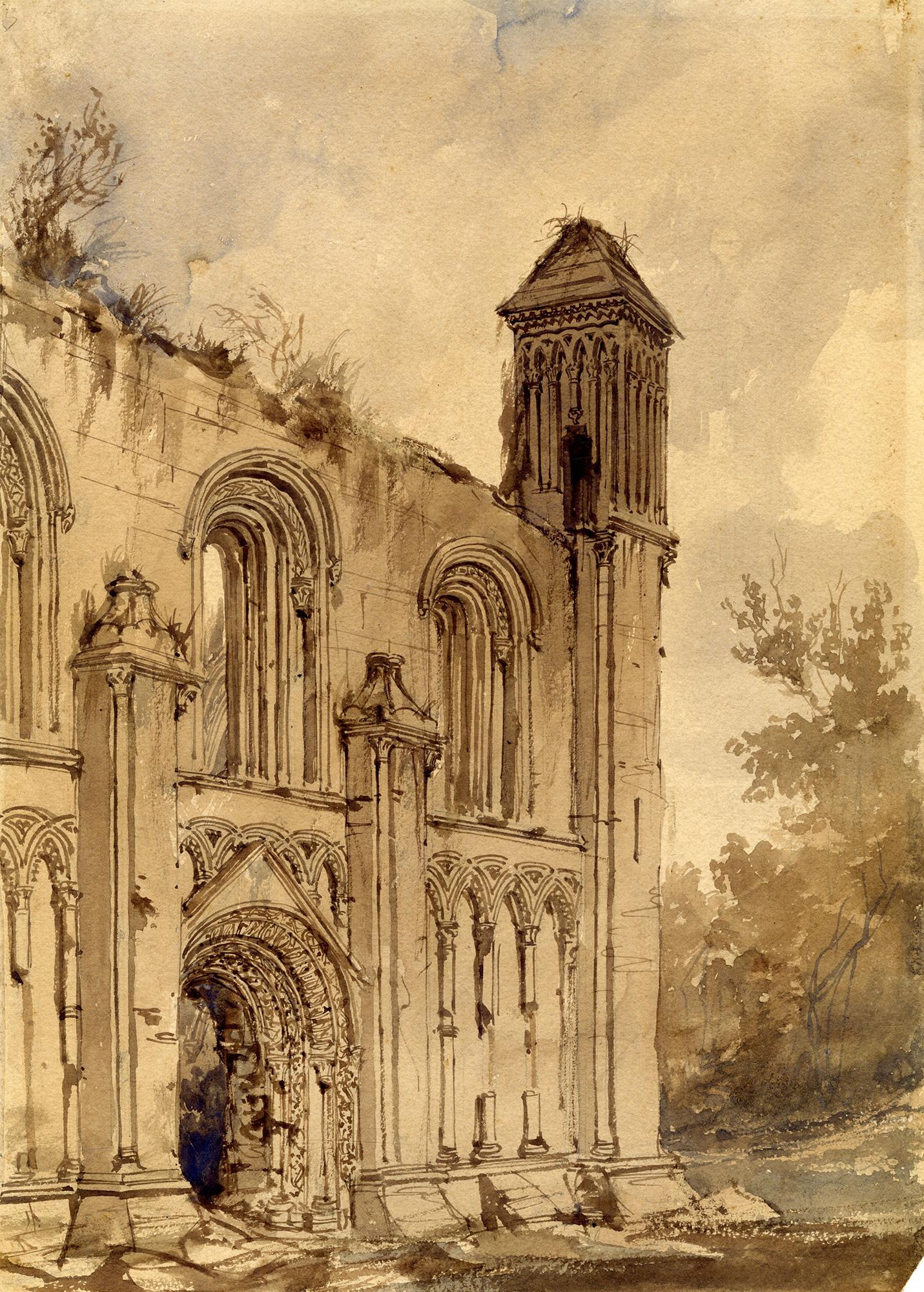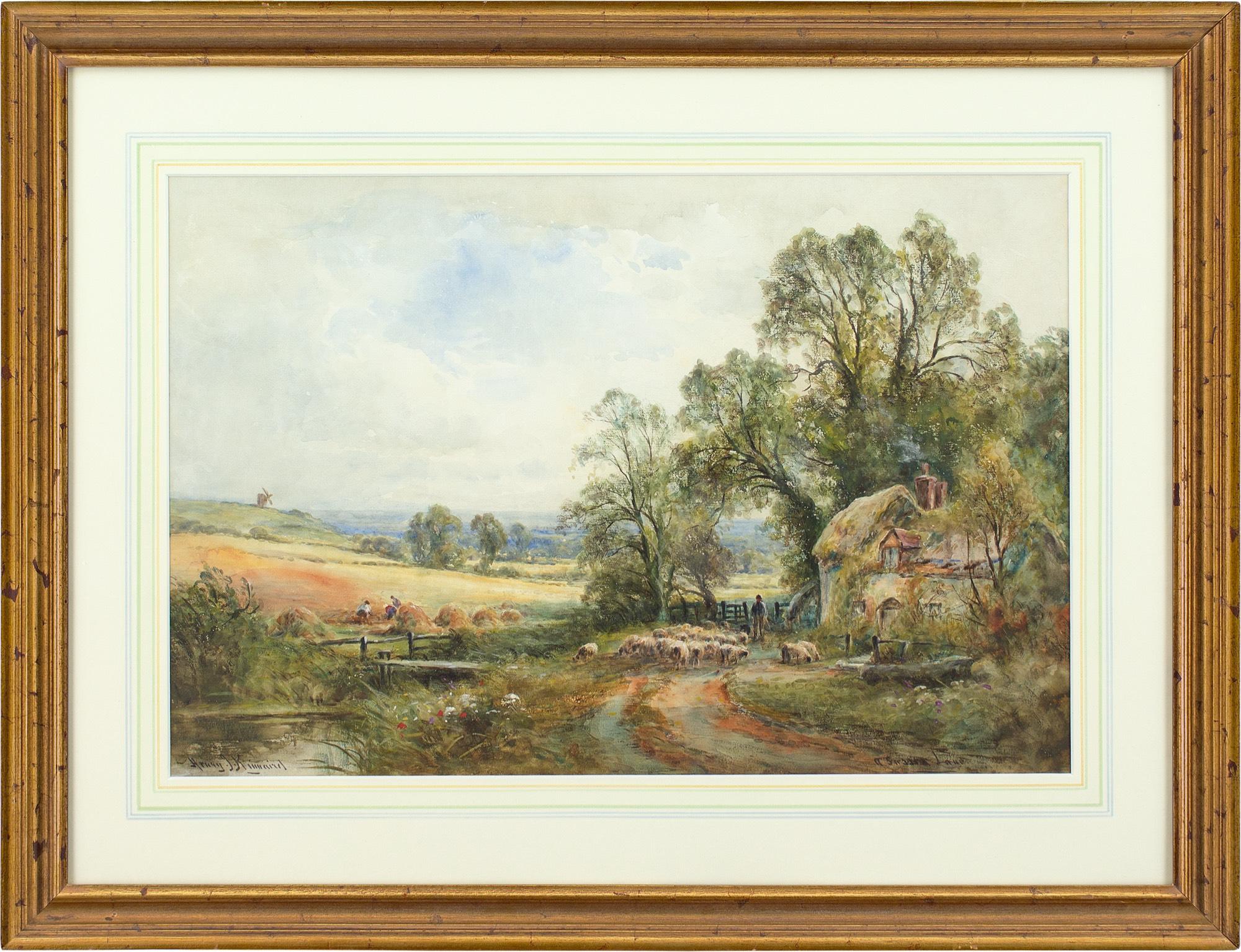Items Similar to John Varley OWS (Attributed), Italianate Landscape With Figures
Want more images or videos?
Request additional images or videos from the seller
1 of 13
John Varley OWS (Attributed), Italianate Landscape With Figuresc. 1830
c. 1830
About the Item
This charming early 19th-century watercolour attributed to English artist John Varley OWS (1778-1842) depicts an Italianate vista with trees, distant town, and figures.
Varley was an energetic watercolourist, astrologer, and close friend of the romantic poet, William Blake. Celebrated by many of his peers, he made a significant contribution to the evolution of early 19th-century watercolour painting.
He trained initially as a silversmith before pursuing an artistic education at Joseph Charles Barrow’s sketching school. Enamoured with the potential of the enthusiastic young man, Barrow took him on a tour of Peterborough where he produced a fine drawing of the cathedral. It was subsequently shown at the Royal Academy and met with much acclaim.
He had a particular skill for flat washes of colour, which conveyed a tranquil, thought-provoking solemnity. Inspired by the masters of landscape, such as Claude Lorrain and the Poussins, he sought to elevate his views above mere topographical representations. Seeking to elicit a feeling of the heart rather than an observation of the mind.
His early works were generally drawn ‘on the spot’ with fresh transparent tints. Lazy sunsets fall across placid lakes. Airy clouds hug subtle peaks with an effortless sense of purity. Less was often more - he omitted the finer details in favour of the overall effect. The wild mountains of North Wales were a frequent destination. As too were the Home Counties, Yorkshire and Northumberland.
In 1805, following several years exhibiting at the Royal Academy, he co-founded the Old Water-Colour Society where he became an influential contributor, showing over 700 works. His genial manner brought much popularity and he was exceedingly generous with artistic advice (whether required or not).
John Constable once wrote that Varley “has just called on me, and I have bought a little drawing off him. He told me how to do landscape, and was so kind as to point out all my defects. The price of the drawing was a guinea and a half to a gentleman, and a guinea only to an artist; but I insisted upon his taking the larger sum, as he had clearly proved to me that I was no artist.”
Eager to develop others, and landscape painting more broadly, he taught numerous students such as David Cox and John Linnell. They’d board with him and work diligently, often accompanied by impromptu poetry or song. Occasionally after class, Varley would don boxing gloves and spar with them. Apparently, he possessed extraordinary agility for a heavyset gentleman. The V&A Museum holds a charming drawing by Mary Ann Flaxman of a sketching session at Varley’s home.
His snippets of wisdom extended beyond his students as when presented with a drawing, he felt entirely compelled to critique it. On one occasion, the sketching ability of a footman at a country house was immeasurably enhanced, to the extent that he too became an artist.
At the peak of his career, Varley was earning in excess of £3,000 per annum. A considerable sum. Yet, due to a combination of endless curiosity and hapless financial decision-making, he was continually broke. Frequently arrested in lieu of payments. Forever the inventor, he designed and patented a six-wheel carriage, investing over £1,000 in the process, but it failed to repay his optimism. He also frittered away countless hours in an attempt to create perpetual motion, eventually dissuaded by his brother, Cornelius.
Stories such as these are plentiful and his name frequently appears in the fond recollections of contemporaries. Such was the nature of his gregarious personality that many were enchanted by his witty anecdotes. Many knew him primarily as an astrologer and often upon meeting a stranger, he’d predict their future. Numerous ladies called upon him under the guise of acquiring a drawing, but in fact, sought to discuss their ‘nativities’.
His fascination for these other-worldly matters was brought to the fore during lengthy discussions with the poet William Blake, which often extended throughout the night. The pair would exchange ideas, with Blake frequently proclaiming that he’d been joined by a vivid apparition - such as a figure from antiquity, or on one occasion, the spirit of a flea. After dozing at a table, Varley was known to rouse in a stupor and ask Blake to call upon Julius Caesar, Edward III or Moses. Blake would retort “there he is!” and proceed to sketch the vision before him, with Varley gazing somewhat blankly into space.
Over the course of his extensive career, John Varley played a vital role in transforming the art of watercolour painting from its humble topographical beginnings into a noble romantic endeavour. A generation of artists were indebted to his direct, yet amiable, suggestions. He’s represented in numerous public collections including the British Museum, the Courtauld in London, the Metropolitan Museum of Art, the Smithsonian American Art Museum, and the National Gallery of Art in Washington DC.
Held within a later frame. Glazed.
Labels & Inscriptions: 'John Varley' inscribed on the reverse (under frame).
Provenance: Private collection, UK.
Artist’s auction maximum: £19,000 for ‘Conway Castle, North Wales’, Watercolour, Sotheby’s, Eighteenth And Nineteenth Century British Drawings And Watercolours, London, 1998.
- Attributed to:John Varley (1778-1842, British)
- Creation Year:c. 1830
- Dimensions:Height: 15.5 in (39.37 cm)Width: 17 in (43.18 cm)
- Medium:
- Movement & Style:
- Period:
- Condition:Assessed and approved by our conservator. Minor discolouration in areas.
- Gallery Location:Cheltenham, GB
- Reference Number:1stDibs: LU2328214374982
About the Seller
5.0
Platinum Seller
These expertly vetted sellers are 1stDibs' most experienced sellers and are rated highest by our customers.
Established in 2017
1stDibs seller since 2023
131 sales on 1stDibs
Typical response time: 1 hour
- ShippingRetrieving quote...Ships From: Cheltenham, United Kingdom
- Return PolicyA return for this item may be initiated within 14 days of delivery.
More From This SellerView All
- James George Philp, On The Derwent, Derbyshire, Antique WatercolourLocated in Cheltenham, GBThis 19th-century watercolour by British artist James George Philp (1816-1885) depicts a tranquil view on the River Derwent in Derbyshire. Meandering between craggy tree-lined banks...Category
Late 19th Century English School Landscape Drawings and Watercolors
MaterialsPaper, Watercolor
- Henry John Kinnaird, A Sussex Lane, Antique WatercolourBy Henry John KinnairdLocated in Cheltenham, GBThis early 20th-century oil painting by British artist Henry John Kinnaird (1880-1920) depicts a quaint pastoral scene in Sussex, England. Tranquillity, harmony and abundant beauty ...Category
1910s English School Landscape Drawings and Watercolors
MaterialsPaper, Watercolor
- Martha Fowler, Sea Fog On The Cornish Coast, Antique WatercolourLocated in Cheltenham, GBThis late 19th-century watercolour by British artist Martha Fowler (b.1843) depicts a view on the Cornish coast. Fisherfolk carry nets amid a haze of dense fog. Meandering between pools of water left by the retreating...Category
1890s English School Landscape Drawings and Watercolors
MaterialsPaper, Watercolor
- Edmond Albert Joseph Tyrel de Poix, Landscape With Pub & SignpostLocated in Cheltenham, GBThis charming 19th-century drawing by British artist Edmond Albert Joseph Tyrel de Poix (1840-1916) depicts a timber-framed public house, figures, horses and a leaning signpost. De ...Category
1870s English School Landscape Drawings and Watercolors
MaterialsPencil, Paper
- Edmond Albert Joseph Tyrel de Poix, Landscape With Watermill, Mother & ChildLocated in Cheltenham, GBThis charming 19th-century drawing by British artist Edmond Albert Joseph Tyrel de Poix (1840-1916) depicts a mother and child standing by a mill pond before a rustic watermill. De Poix was a gentleman artist descended from French nobility...Category
1870s English School Landscape Drawings and Watercolors
MaterialsPencil, Paper
- 19th-Century Swiss School, Montbenon, Lake GenevaLocated in Cheltenham, GBThis mid-19th-century Swiss school drawing depicts the beautiful Esplanade de Montbenon in Lausanne, Switzerland. The picturesque gardens of the Esplanade de Montbenon provide a spl...Category
1830s Folk Art Landscape Drawings and Watercolors
MaterialsPaper, Watercolor, Gouache, Pencil
You May Also Like
- English School watercolour, Figures on a country track with a castle beyondLocated in Harkstead, GBA lovely rural scene with figures walking on a country track, pausing for a moment to chat and gaze over towards the castle in the woods. Circle of William Leighton Leitch (1804-188...Category
Mid-19th Century English School Figurative Drawings and Watercolors
MaterialsWatercolor, Pencil, Paper
- Circle of George Chinnery, 19th Century, Chinese Sumo wrestlers in a landscapeLocated in Harkstead, GBA fascinating 19th century view of Chinese Sumo wrestlers in a mountainous landscape Circle of George Chinnery (1774-1852) Chinese wrestlers in a land...Category
Mid-19th Century English School Figurative Drawings and Watercolors
MaterialsPaper, Watercolor
- The Gatehouse, St. Mary Abbey, YorkLocated in Middletown, NYInk and wash in sepia and brown on heavy wove paper, 5 13/16 x 8 1/2 inches (146 x 215 mm). Scattered uniform age tone and discoloration throughout. Brown ink spot with associated sp...Category
Early 19th Century English School Landscape Drawings and Watercolors
MaterialsInk, Watercolor, Handmade Paper
- Glastonbury AbbeyBy Frederick NashLocated in Middletown, NYInk wash with watercolor in sepia and black, and blue, on buff wove watercolor paper, 14 1/4 x 10 1/4 inches (360 x 260 mm). 1/4" of the lower right corner is lost, minor crack (doe...Category
Mid-19th Century English School Landscape Drawings and Watercolors
MaterialsInk, Watercolor, Handmade Paper
- Yellow Grass Hill - 19th Century English SchoolLocated in Middletown, NYWatercolor on white wove watercolor paper, 6 1/2 x 10 inches (165 x 255 mm). Dated "January 2/'86" in pencil on the verso. In good condition with some minor toning and light areas of...Category
Mid-19th Century English School Landscape Drawings and Watercolors
MaterialsPaper, Watercolor
- English School watercolour, A figure by a Scottish castle and lochLocated in Harkstead, GBA charming scene of a figure by a loch with a ruined castle and homestead in the background by one of Queen Victoria's favourite artists. William Leighton Leitch (1804-1883) Figure ...Category
Mid-19th Century English School Figurative Drawings and Watercolors
MaterialsWatercolor, Paper, Pencil
Recently Viewed
View AllMore Ways To Browse
General Braddock
Happy Birthday Miss Jones
Herzog Desk
Jacques Bartoli
Les Bernard Pin
Meditations In An Emergency
Mulberry Organizer
Paintings Laguna Niguel
Paul Demeter
Pizza Hut
Salvador Dali Signed Prints Quotes
Strawberry Slice Table
Vivian Collins
Wren House Light
Zephyr Bird Miro
Ahmed Nawar
Amerika Martin
Angelo Titonel
